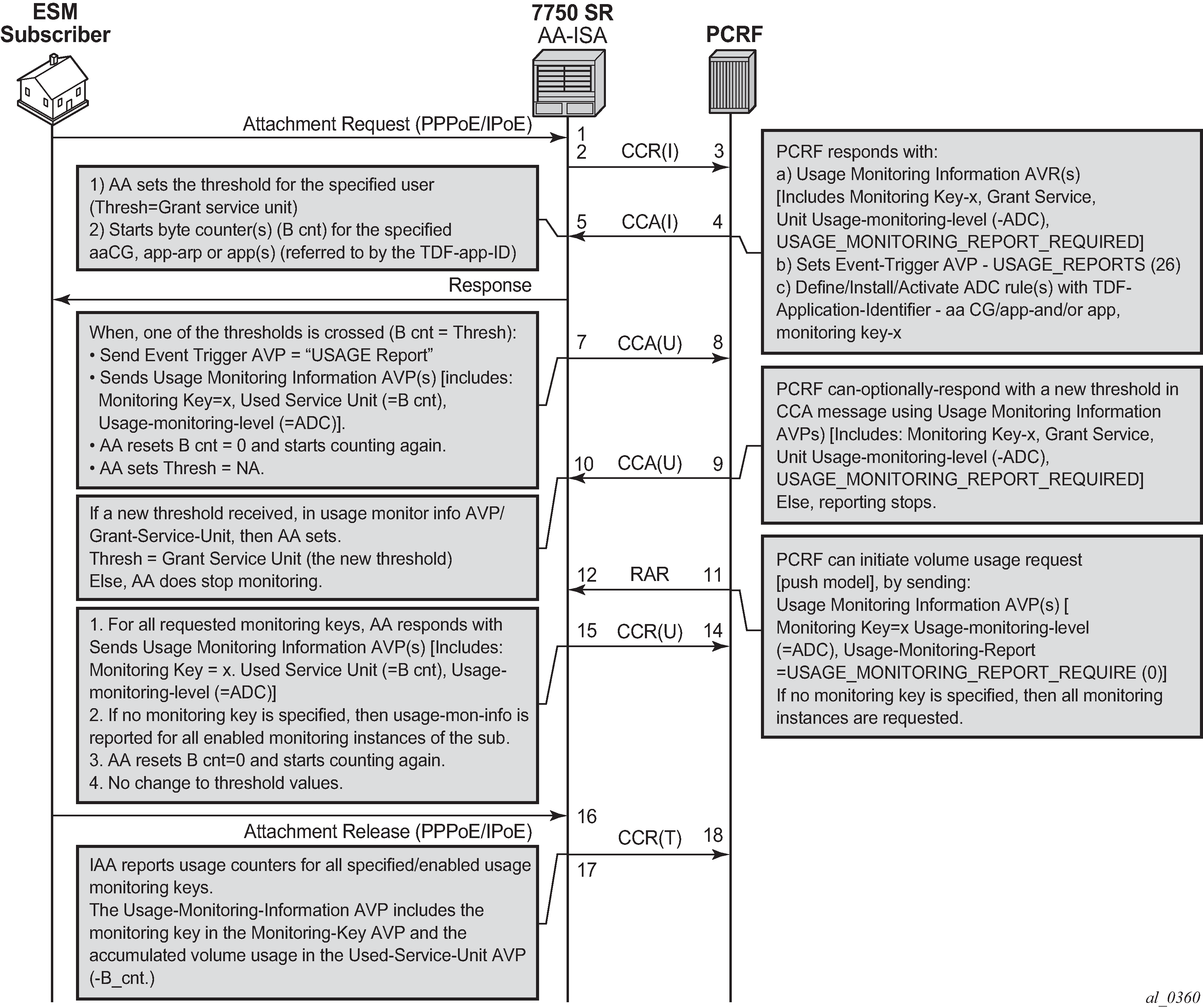Using 3GPP (third generation Partnership Project) diameter (Gx) functionality, AA ISA upon receiving requests from Policy and Charging Rules Function (PCRF), can monitor application usage at the subscriber’s level and report back to PCRF whenever the usage exceeds the thresholds set by the PCRF.
Usage-monitoring can be used by operators to report to PCRF when:
AA ISA detects the start of a subscriber application (by setting usage threshold to be very low).
A pre-set usage volume per subscriber application is exceeded.
AA can monitor subscriber’s traffic for any defined:
application
application group
charging group
AA ISA Gx-based usage monitoring is restricted to AA ESM and transit AA subscribers’ type therefore it is only supported on 7750 SR.
The AA ISA Gx usage monitoring feature builds on 3GPP Release 11 defined Application Detection and Control (ADC) Gx attributes. In addition, AA ISA is compliant with 3GPP Release 12, whereby the ADC rule functionality is integrated in the PCC rules.
AA ISA reports accumulated usage when:
A usage threshold is reached.
The PCRF explicitly disables usage monitoring.
The PCRF requests for a report.
When the ADC or PCC rule associated with the monitoring instance is removed or deactivated.
When a session is terminated.
An AA defined application, application group or charging group is automatically allowed to be referenced by a an ADC rule for the purpose of usage monitoring only if:
-
It is already selected for either XML or Radius per subscriber accounting.
-
It is explicitly enabled by the operator for per sub statistics collection.
-
Usage monitoring is enabled for the specific AA group:partition.
Figure: Usage monitoring illustrates the different messaging /call flows involved in application level usage monitoring. For details about the supported AVPs used in these messages, see section Supported AVPs.

AA ISA (the PCEF) supports Usage-Thresholds AVPs that refer to the thresholds (in byte) at which point an event needs to be sent back to the PCRF (Figure: Usage monitoring).
No time based thresholds are supported.
AA supports grant-service-unit AVP using the following possible values (AVP):
CC-Input-Octets AVP (code 412): From Subscriber total byte count threshold
CC-Output-Octet AVP (code 414): To subscriber total byte count threshold
CC-Total-octets AVP (code 421): Threshold of aggregate traffic (Input and Output byte counters)
As shown in Figure: Usage monitoring (T=7), AA sends a CCR message with a USAGE_REPORT Event-Trigger AVP to the PCRF when the usage counter reaches the configured usage monitoring threshold for a subscriber (and an application group). AA counters are reset (to zero) when the monitoring threshold is reached (and an event is sent back to PCRF). The counters, however, do not stop counting newly arriving traffic. AA counters only include ‟admitted” packets. Any packets that got discarded by AA because of –say- policing actions- are not counted for usage-monitoring purposes.
The TDF-Application-Identifier AVP–within the ADC or PCC rule- refers to AA Charging group, AA application group or to an AA application.
TDF-Application-Identifiers (such as charging-groups) have to be manually entered at the PCRF to match AA charging groups configured on the 7750 SR.
If the TDF-Application-Identifiers refers to a name that is used for both a charging group and an application (or application group), AA monitors the charging group. In other words, AA charging group has higher precedence than AA application group.